土壤是一个非常复杂的多孔多相系统,它的物理性质具有显著的空间和时间变异性。在土壤物理性质的研究中,土壤水和土壤热特性是两项十分重要的内容。其中,土壤水是土壤重要的组成部分,对农田灌溉、地质工程、生态系统组成等均具有重要影响[1];而土壤热特性包括热扩散率、热容量和热导率,它们是反映土壤温度变化快慢、保持和传输热量能力的基本物理参数[2]。土壤水和土壤热特性是研究土壤物理过程的前提,如水热耦合传导、溶质运移等。
为了深入研究土壤物理过程并对土壤物理性质进行更好地监控和测量,很多研究专注于土壤水和土壤热特性的准确测量,并通过理论研究、建立模型、科学实验等提出了很多测量技术。其中,测量土壤水分含量的方法包括传统烘干法、电容法、中子法、时域反射法、热脉冲探针等;而测量土壤热特性的方法包括稳态法和瞬态法,瞬态法中最常用的是瞬态平面热源法和热脉冲探针。
由此可见,热脉冲探针不仅可以监测土壤水分[3],也可以测量土壤热特性[4]。热脉冲探针又包括单针法和双针法,其中双针法[5-7]已广泛应用于土壤水分含量[8]、土壤热特性[9]以及地表土壤水分蒸发[10]的测量和计算。双针法包括两个探针,一个加热针和一个温度针,探针间距指加热针和温度针之间的距离,它对测量土壤热特性参数的准确性影响较大。有研究表明,当加热针或温度针发生1°倾斜时,将导致热导率和热容量的测量结果产生超过10%的误差[11]。在测量过程中,尤其是野外实地测量,在将探针插入土壤时,探针间距可能因土壤的穿透阻力而改变;并且,由于冻融作用、生物运动、植物根系生长等造成土壤的膨胀或收缩,也可能导致探针的倾斜从而使探针间距发生改变。因此,原位校准探针间距是非常必要的。于是,Liu等[7, 12]提出了一种新型的双针设计来原位校正探针间距,降低由于探针间距变化而产生的测量误差。本研究利用新型的双针设计来监测野外实地测量过程中探针间距的变化,并讨论探针间距发生变化的原因。
1 材料与方法 1.1 研究区概况本研究的野外实验在中国农业大学上庄试验站北站进行,该试验站位于北京市海淀区上庄乡(40°8′N,116°10′E,海拔约48 m),气候类型为暖温带半湿润大陆性季风气候,夏季高温多雨,冬季寒冷干燥,年平均降雨量为600 mm,且集中于6-9月,该时期的降雨量占全年降雨总量的72.5%[13],主要种植作物为玉米、小麦等。
1.2 双针法的工作原理双针法由一个温度针和一个加热针构成(如图 1),两个探针之间的间距为r,基于无限线性热源模型(ILS)[14],距离加热针径向距离r处温度与初始温度(t=0时刻)的差ΔT随时间t的变化可以表示为:
| $ \Delta T\left( {r, t} \right) = \left\{ {\begin{array}{*{20}{c}} {\frac{{- q'}}{{4\pi \alpha \rho c}}{\rm{Ei}}\left[{\frac{{-{r^2}}}{{4\alpha t}}} \right]\;t < {t_0}}\\ {\frac{{q'}}{{4\pi \alpha \rho c}}\left\{ {{\rm{Ei}}\left[{\frac{{-{r^2}}}{{4\alpha \left( {t-{t_0}} \right)}}} \right] - {\rm{Ei}}\left[{\frac{{-{r^2}}}{{4\alpha t}}} \right]} \right\}\;t > {t_0}} \end{array}} \right. $ | (1) |
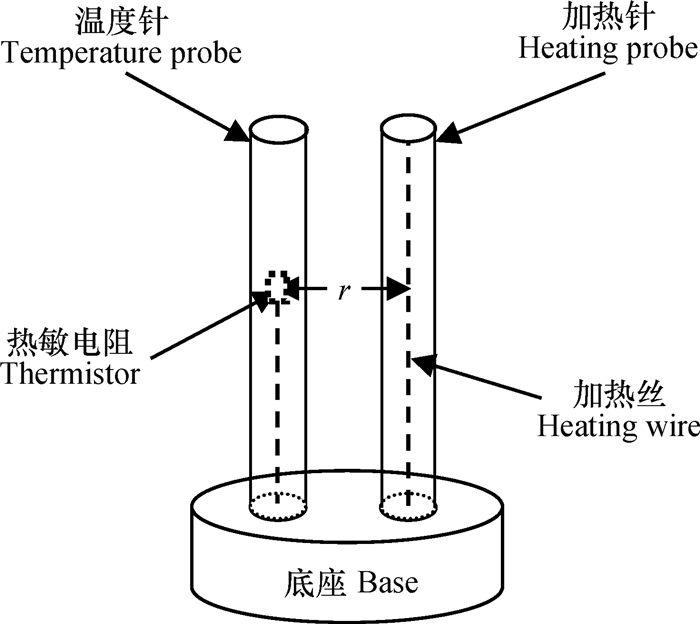
|
图 1 双针热脉冲的结构示意图 Fig. 1 Schematic of dual heat pulse probe apparatus |
式中,Ei为指数积分,α为热扩散系数(m2 s-1),ρ为土壤容重(kg m-3),c为土壤比热容(J kg-1 K-1),ρc即为土壤的体积热容量(J m-3 K-1),t0为加热时间(s)。通过∆T随t的变化,非线性拟合得到达到最高温度差∆Tm时所对应的时间tm[15],再根据式2和式3分别计算热扩散系数α和体积热容量ρc[9]:
| $ \alpha = \frac{{{r^2}}}{4}\left\{ {\frac{{1/\left( {{t_m}- {t_0}} \right)- 1/{t_m}}}{{\ln \left[{{t_m}/\left( {{t_m}-{t_\mathit{0}}} \right)} \right]}}} \right\} $ | (2) |
| $ \rho c = \frac{{q'}}{{4\pi \alpha \Delta {T_m}}}\left\{ {Ei\left[{\frac{{-{r^2}}}{{4\alpha \left( {{t_m}-{t_0}} \right)}}} \right] -Ei\left( {\frac{{ -{r^2}}}{{4\alpha {t_m}}}} \right)} \right\} $ | (3) |
应用双针法在野外实地测量土壤热特性时,由于土壤温度处于时刻波动状态,因此本研究应用Jury和Bellantuoni[16]对背景温度的校正方法进行校正。探针在制作时插入一定间距的PVC管中进行固定,并在室内用琼脂溶液标定探针的初始间距。然而,由于实际测量过程中,探针因各种环境因素,例如土壤冻结或解冻、耕作等,使得探针发生倾斜,改变了探针间距,使得探针的初始间距与野外测量时探针的实际间距间产生误差,造成测量热特性的结果偏离真实值。于是Liu等[7]将双针热脉冲探针进行改进,来实地校正探针间距,从而更准确地测量材料的热特性。
1.3 改进后双针法的工作原理[7]改进后的双针法即在同一根温度针中的不同位置处放置两个热敏电阻(如图 2),称为热敏电阻1和热敏电阻2。当探针未发生倾斜时,热敏电阻与加热针的间距分别为r10和r20(即初始间距);当探针发生倾斜时,热敏电阻与加热针的间距分别为r1和r2(即实际间距),于是热敏电阻产生径向距离偏差∆r1和∆r2。两个热敏电阻测得的热扩散系数分别为α1和α2,定义
| $ {\eta _1} = \frac{{\frac{1}{{\left( {{t_{m1}}- {t_0}} \right)}}- \frac{1}{{{t_{m1}}}}}}{{\ln \left[{\frac{{{t_{m1}}}}{{\left( {{t_{m1}}-{t_0}} \right)}}} \right]}};{\eta _2} = \frac{{\frac{1}{{\left( {{t_{m2}} - {t_0}} \right)}} - \frac{1}{{{t_{m2}}}}}}{{\ln \left[{\frac{{{t_{m2}}}}{{\left( {{t_{m2}}-{t_0}} \right)}}} \right]}} $ | (4) |
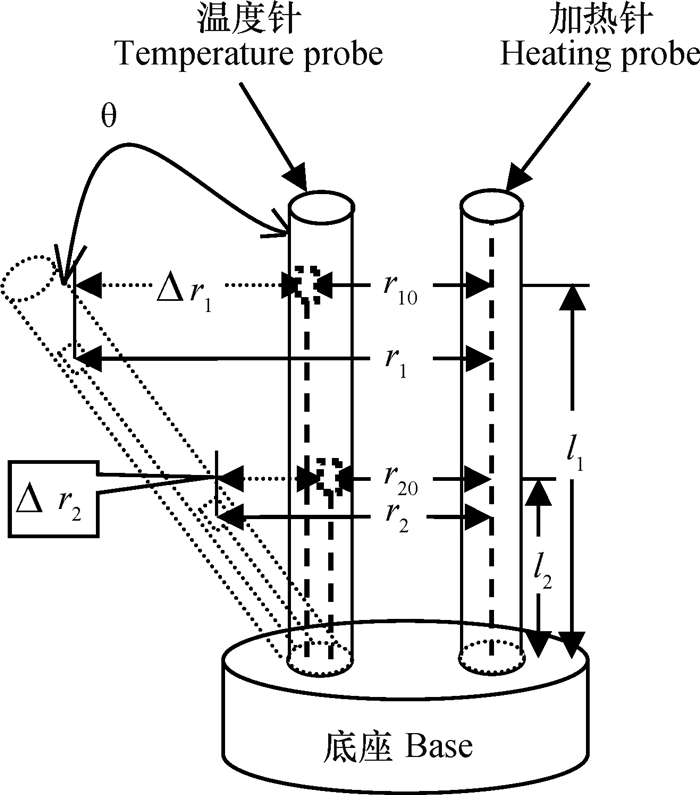
|
图 2 改进后双针热脉冲的结构示意图 Fig. 2 Schematic of the modified dual heat pulse probe apparatus |
对于质地均匀的固体材料,热敏电阻测得的α相同,即α1=α2,令:
| $ p = \frac{{{r_1}}}{{{r_2}}} = \sqrt {\frac{{{\eta _2}}}{{{\eta _1}}}} $ | (5) |
当p=1时,r1=r2,η1=η2,即探针不发生倾斜,测得的α1和α2相同。
本研究假设探针只发生共面倾斜,分为两种情况:外倾和内倾,并以外倾情况为例做详细介绍。
如图 2所示,假定探针发生很轻微的向外倾斜,且倾斜角为θ,则有:
| $ \Delta {r_1} = {l_1} \times \tan \theta \approx {l_1} \times \sin \theta ;\;\Delta {r_2} = {l_2} \times \tan \theta \approx {l_2} \times \sin \theta $ | (6) |
式中,l1和l2分别为热敏电阻1和2距离底座的距离。探针的实际间距和初始间距满足:
| $ {r_1} = {r_{10}} + \Delta {r_1};\;\;{r_2} = {r_{20}} + \Delta {r_2} $ | (7) |
将式(6)和式(7)代入式(5),即:
| $ p = \frac{{{r_{10}} + {l_1} \times \sin \theta }}{{{r_{20}} + {l_2} \times \sin \theta }} $ | (8) |
则可以计算出倾斜角θ为:
| $ \theta = {\sin ^{-1}}\left( {\frac{{p \times {r_{20}}-{r_{10}}}}{{{l_2}-{l_1} \times p}}} \right) $ | (9) |
于是得到实际间距为:
| $ {r_1} = {r_{10}} + {l_1} \times \sin \theta ;\;\;{r_2} = {r_{20}}{ + _2} \times \sin \theta $ | (10) |
探针的具体制作过程参考Liu等[7]和Wen等[17]两篇文章,探针的物理参数如表 1中记录所示,两个热敏电阻的位置分别为l1=15 mm,l2=30 mm。温度针中的热敏电阻与数据采集仪(型号CR1000,Campbell Scientific公司,Logan,UT)连接,加热针的加热丝为镍铬合金丝(Nichrome A,直径79μm,电阻率为205Ωm-1),加热针和数据采集仪依靠太阳能供电系统(包括20 W太阳能电池板、12 V蓄电池和太阳能控制器)供电。野外试验前,在琼脂溶液中标定探针的初始间距(r10和r20)。加热针的加热时间t0=16 s,数据采集仪记录180s温度数据,其中包括加热开始前测量60 s背景温度,加热开始后测量120 s温度变化。
|
|
表 1 探针的物理性质 Table 1 Physical properties of the probes |
探针的野外布置埋设如图 3所示,探针水平插入深度为3 cm、8 cm和13 cm的土壤中。测量时间为2015年5月19日至2015年7月3日(按日计为第139-184天,共46天),以及2016年2月11日至2016年3月28日(按日计为第42-88天,共47天)期间,测量周期为1 h。
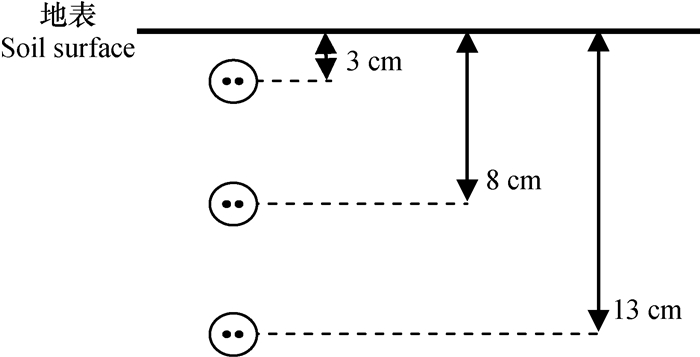
|
图 3 探针布置埋设图 Fig. 3 Distribution map of probes |
结果显示5月-7月(第139-184天)期间,3 cm埋深处的探针间距变化幅度较大,而8 cm和13 cm埋深处的探针间距变化幅度较小(如图 4)。3 cm处探针间距变化幅度较大的原因可能是由于夏季植物根系生长或降雨造成土壤干湿交替而产生开裂[18-19],使得间距变化幅度较大;也可能是由于表层土壤质地比较疏松,探针与土壤颗粒之间存在热接触问题[20],使得测量结果存在较大的误差,造成探针间距的变化幅度增大。而对于深层土壤(8 cm和13 cm),土壤质地较为紧实,探针与土壤之间的热接触误差很小,所以测量结果的误差小且比较稳定,从而深层土壤中探针间距的变化幅度很小。

|
图 4 5-7月土壤中不同深度处探针间距及温度变化 Fig. 4 Probe spacing and temperature variations during the period from May to July relative to depth of the probe embedment |
次年2月-3月(第42-88天)期间,由于8 cm埋深处的探针在农业耕作时损坏,所以数据记录只有3 cm和13 cm埋深。结果显示,此期间3 cm埋深处的探针测量土壤热特性时存在断点现象(即部分数据无法拟合得到结果或测量得到土壤的热特性参数不准确),而13 cm埋深处探针间距变化不明显(如图 5)。3 cm埋深处存在断点现象(第46、52、55、56、57、60天数据缺失)的主要原因是在第42~62天期间,3 cm深度处土壤温度低于0℃,土壤中水分结冰,加热针产生的一部分热量用于水的相变吸热,在加热开始后120 s内温度持续上升且温差较小(<0.5℃),从而造成探针测量热特性时存在较大误差,并且土壤的冻融交替也会造成探针间距的变化;第62天后,土壤温度开始回升,高于0℃,土壤不再冻结,且此时由于植物未生长且降水很少,土壤处于较为稳定的状态,所以探针间距趋于稳定。而13 cm深度处探针间距几乎没有变化的原因是因为土壤温度始终高于0℃,土壤未结冰,不存在冻土层的影响,所以探针间距的变化幅度很小。
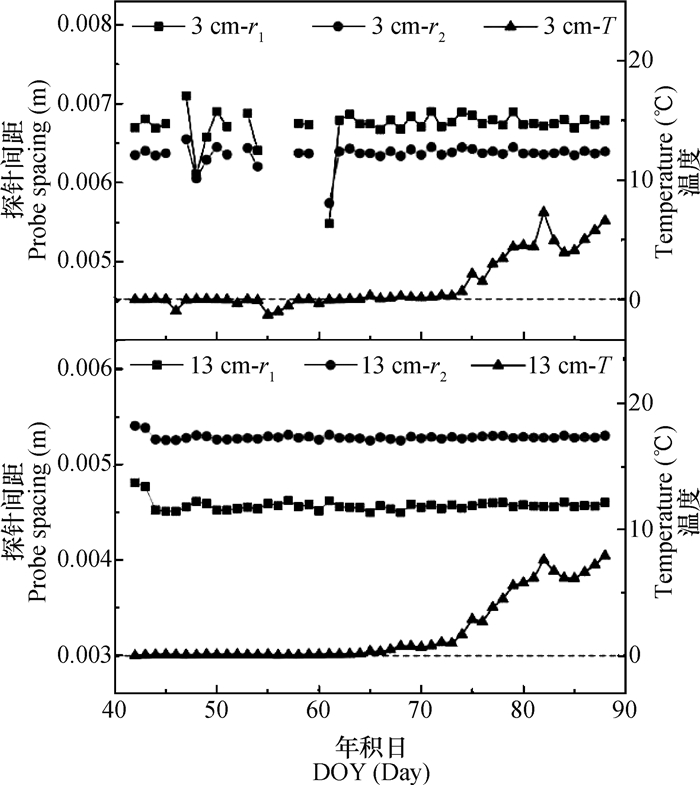
|
图 5 次年2-3月土壤中不同深度处探针间距及温度变化 Fig. 5 Probe spacing and temperature variations during the period from February to March relative to depth of the probe embedment |
事实上,探针间距对热导率的测量并无影响,即无论是否校正探针间距,热导率的测量结果均一致。这是因为,Noborio等[21]推导出热导率的计算公式为:
| $ \lambda = \frac{{q'}}{{4{\rm{ \mathsf{ π} }}\Delta {T_m}}}\left( {{\rm{Ei}}\left\{ {\frac{{- \ln \left[{{t_m}/\left( {{t_m}-{t_0}} \right)} \right]}}{{{t_0}/{t_m}}}} \right\} - {\rm{Ei}}\left\{ {\frac{{ - \ln \left[{{t_m}/\left( {{t_m}-{t_0}} \right)} \right]}}{{{t_0}/\left( {{t_m} -{t_0}} \right)}}} \right\}} \right) $ | (11) |
式中,热导率λ与探针间距r无关,只与tm、t0、ΔTm和q'有关,对于一根探针上的两个热敏电阻,t0和q'均为常数,所以λ取决于两个热敏电阻测量得到的tm1和ΔTm1、tm2和ΔTm2,对于均质土壤,tm1=tm2、ΔTm1=ΔTm2,即λ1=λ2。且Kluitenberg[22]证实探针倾斜造成探针间距的变化,这对热导率的测量结果并无显著影响。
分别选取5-7月和次年2-3月期间每七天的热导率测量结果(与选取热导率结果的时间点相同),用同一根探针上两个不同位置的热敏电阻测量得到的热导率(分别计作λ1和λ2)分别作为横纵坐标进行对比(如图 6~图 7)。结果显示,探针测量得到的热导率均可以较好地符合1:1线,即同一根探针上的两个热敏电阻测量得到的热导率差异较小,这说明土壤质地是均匀的;只有在冬季(次年2-3月)3 cm深度处热导率偏离1:1线,产生这种结果的可能原因是由于冻土层的存在,造成热导率测量结果的不准确,也可能是由于土壤变异性大,使得土壤不均质性明显,即使相距15 mm的土壤的热特性也存在较大差异。

|
图 6 5-7月土壤中不同深度处的热导率对比 Fig. 6 Heat conductivity during the period from May to July relative to soil depth |
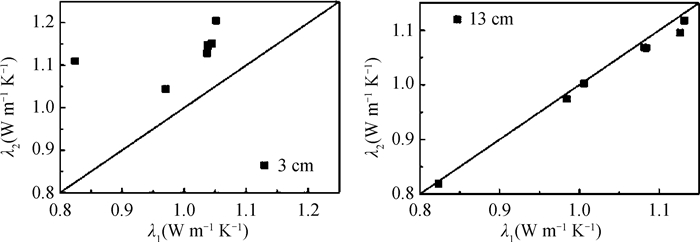
|
图 7 次年2-3月土壤中不同深度处的热导率对比 Fig. 7 Heat conductivity during the period from February to March relative to soil depth |
分别选取5-7月和次年2-3月期间每七天测量体积热容量的结果(与选取热导率结果的时间点相同),计算探针间距校正前后同一根探针上两个不同位置的热敏电阻测量体积热容量的绝对误差以及探针偏转度(如表 2~表 3)。在2.2.1中,热导率的测量结果说明除冬季(次年2-3月)3 cm深度处土壤是非均质的外,其余情况下的土壤均为均质,所以体积热容量的误差主要来自于探针间距,且相对误差越大,探针间距与实际间距之间的差异越大。
|
|
表 2 5-7月体积热容量测量结果的相对误差和探针偏转度 Table 2 Relative deviation of the measurement of volumetric heat capacity and deviation of the probes during the period from May to July |
结果显示,未校正探针间距时,体积热容量测量结果的相对误差大多在10%以上,部分值甚至超过20%,而校正探针间距后,相对误差明显减小,大多小于5%(表 2和表 3)。表 2中第153天间距校正前后体积热容量的相对误差增大,原因可能是由于探针倾斜角度过大,违反了间距校正的原理假设(式6);也可能是探针发生非共面倾斜,造成校正不准的现象。在冬季(次年2-3月)3 cm深度处,体积热容量相对误差增大,产生这种结果的可能原因是由于冻土层的存在,造成热导率测量结果的不准确;也可能是土壤变异性较大使得土壤非均质性明显造成的。
|
|
表 3 次年2-3月体积热容量测量结果的相对误差和探针偏转度 Table 3 Relative deviation of the measurement of volumetric heat capacity and deviation of probes during the period from February to March |
通过改进后的双针法在夏季和冬季两个季节野外土壤热特性的监测中,发现探针间距在土壤表层中变化较大,但在较深层土壤中探针间距比较稳定。而土壤表层的水分含量、热特性参数、温度变化等物理参数对作物生长十分重要,因此探针间距的校正是非常必要的。本研究结果分析显示,热脉冲探针间距的校正方法可以明显降低体积热容量的测量误差,并且该校正方法可以很好地应用于野外试验中。但由于冬季表层土壤存在冻土层,使得无法准确分析热脉冲探针测量的土壤热特性的结果,从而探针间距的校正也无法很好地应用。因此,下一步的工作是针对一年四季对野外探针间距的变化进行监测,并进一步研究探针间距变化的原因。
| [1] |
张晓, 王月月, 任图生. 利用热脉冲技术测量土壤表层含水率. 农业工程学报, 2015, 31(2): 72-78. Zhang X, Wang Y Y, Ren T S. Measuring soil water content in surface layer with heat-pulse technique (In Chinese). Transactions of the Chinese Society of Agricultural Engineering, 2015, 31(2): 72-78. (  0) 0) |
| [2] |
付永威, 卢奕丽, 任图生. 探针有限特性对热脉冲技术测定土壤热特性的影响. 农业工程学报, 2014, 30(19): 71-77. Fu Y W, Lu Y L, Ren T S. Influences of finite probe property on soil thermal property estimated by heat pulse technique (In Chinese). Transactions of the Chinese Society of Agricultural Engineering, 2014, 30(19): 71-77. DOI:10.3969/j.issn.1002-6819.2014.19.009 (  0) 0) |
| [3] |
李毅, 邵明安. 热脉冲法测定土壤热性质的研究进展. 土壤学报, 2005, 42(1): 134-139. Li Y, Shao M A. Latest advance of thermo-pulse method for measuring soil thermal properties (In Chinese). Acta Pedologica Sinica, 2005, 42(1): 134-139. DOI:10.11766/trxb200401070121 (  0) 0) |
| [4] |
米美霞, 樊军, 邵明安. 利用热脉冲技术研究石子覆盖对土壤内部蒸发的影响. 土壤学报, 2013, 50(1): 75-82. Mi M X, Fan J, Shao M A. Study of effects of gravel mulch on soil evaporation using heat pulse technology (In Chinese). Acta Pedologica Sinica, 2013, 50(1): 75-82. DOI:10.11766/trxb201202060024 (  0) 0) |
| [5] |
Bristow K L. Measurement of thermal properties and water content of unsaturated sandy soil using dual-probe heat-pulse probes . Agricultural and Forest Meteorology, 1998, 89(2): 75-84. DOI:10.1016/S0168-1923(97)00065-8
(  0) 0) |
| [6] |
Mori Y, Hopmans J W, Mortensen A P, et al. Multi-functional heat pulse probe for the simultaneous measurement of soil water content solute concentration, and heat transport parameters . Vadose Zone Journal, 2003, 2(4): 561-571. DOI:10.2136/vzj2003.5610
(  0) 0) |
| [7] |
Liu G, Wen M M, Chang X P, et al. A self-calibrated DPHP sensor for in situ calibrating the probe spacing . Soil Science Society of America Journal, 2013, 77(2): 417-421. DOI:10.2136/sssaj2012.0434n
(  0) 0) |
| [8] |
Tarara J M, Ham J M. Measuring sensible heat flux in plastic mulch culture with aerodynamic conductance sensors . Agricultural and Forest Meteorology, 1999, 95(1): 1-13. DOI:10.1016/S0168-1923(99)00021-0
(  0) 0) |
| [9] |
Bristow K L, Kluitenberg G J, Horton R. Measurement of soil thermal properties with a dual-probe heat-pulse technique . Soil Science Society of America Journal, 1994, 58(5): 1288-1294. DOI:10.2136/sssaj1994.03615995005800050002x
(  0) 0) |
| [10] |
Heitman J L, Horton R, Sauer T J, et al. Sensible heat observations reveal soil water evaporation dynamics . Journal of Hydrometeorology, 2008, 9(1): 165-171. DOI:10.1175/2007JHM963.1
(  0) 0) |
| [11] |
Liu G, Li B G, Ren T S, et al. Analytical solution of heat pulse method in a parallelepiped sample space with inclined needles . Soil Science Society of America Journal, 2008, 72(5): 1208-1216. DOI:10.2136/sssaj2007.0260
(  0) 0) |
| [12] |
Liu G, Wen M M, Ren R Q, et al. A general in situ probe spacing correction method for DPHP sensor . Agricultural and Forest Meteorology, 2016, 226: 50-56.
(  0) 0) |
| [13] |
徐宗学, 张玲, 阮本清. 北京地区降水量时空分布规律分析. 干旱区地理, 2006, 29(2): 186-192. Xu Z X, Zhang L, Ruan B Q. Analysis on the spatiotemporal distribution of precipitation in the Beijing Region (In Chinese). Arid Land Geography, 2006, 29(2): 186-192. (  0) 0) |
| [14] |
de Vries D A. A nonstationary method for determining thermal conductivity of soil in situ . Soil Science, 1952, 73(2): 83-89. DOI:10.1097/00010694-195202000-00001
(  0) 0) |
| [15] |
Welch S M, Kluitenberg G J, Bristow K L. Rapid numerical estimation of soil thermal properties for a broad class of heat-pulse emitter geometries . Measurement Science and Technology, 1996, 7(6): 932-938. DOI:10.1088/0957-0233/7/6/012
(  0) 0) |
| [16] |
Jury W A, Bellantuoni B A. Background temperature correction for thermal conductivity probes . Soil Science Society of America Journal, 1976, 40(4): 608-610. DOI:10.2136/sssaj1976.03615995004000040040x
(  0) 0) |
| [17] |
Wen M M, Liu G, Li B G, et al. Evaluation of a self-correcting dual probe heat pulse sensor . Agricultural and Forest Meteorology, 2015, 200: 203-208. DOI:10.1016/j.agrformet.2014.09.022
(  0) 0) |
| [18] |
Tang C S, Cui Y J, Shi B, et al. Desiccation and cracking behaviour of clay layer from slurry state under wetting-drying cycles . Geoderma, 2011, 166(1): 111-118. DOI:10.1016/j.geoderma.2011.07.018
(  0) 0) |
| [19] |
Velde B. Structure of surface cracks in soil and muds . Geoderma, 1999, 93(1): 101-124.
(  0) 0) |
| [20] |
Cobos D R, Baker J M. In situ measurement of soil heat flux with the gradient method . Vadose Zone Journal, 2003, 2(4): 589-594. DOI:10.2136/vzj2003.5890
(  0) 0) |
| [21] |
Noborio K, McInnes K J, Heilman J L. Measurements of soil water content, heat capacity, and thermal conductivity with a single TDR probe . Soil Science, 1996, 161(1): 22-28. DOI:10.1097/00010694-199601000-00004
(  0) 0) |
| [22] |
Kluitenberg G J, Kamai T, Vrugtcd J A, et al. Effect of probe deflection on dual-probe heat-pulse thermal conductivity measurements . Soil Science Society of America Journal, 2010, 74(5): 1537-1540. DOI:10.2136/sssaj2010.0016N
(  0) 0) |
 2018, Vol. 55
2018, Vol. 55


